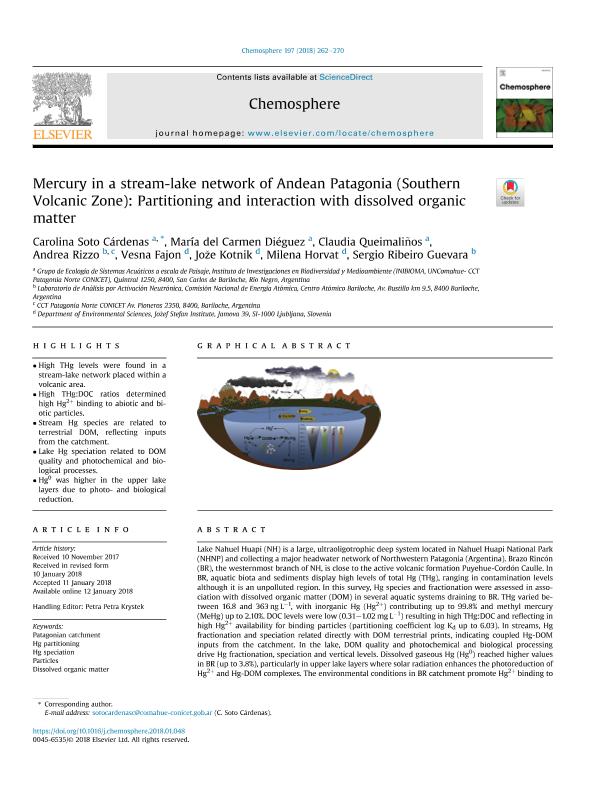Artículo
Mercury in a stream-lake network of Andean Patagonia (Southern Volcanic Zone): Partitioning and interaction with dissolved organic matter
Soto Cárdenas, Estela Carolina ; Dieguez, Maria del Carmen
; Dieguez, Maria del Carmen ; Queimaliños, Claudia Patricia
; Queimaliños, Claudia Patricia ; Rizzo, Andrea Paula
; Rizzo, Andrea Paula ; Fajon, Vesna; Kotnik, Joze; Horvat, Milena; Ribeiro, Sergio
; Fajon, Vesna; Kotnik, Joze; Horvat, Milena; Ribeiro, Sergio
 ; Dieguez, Maria del Carmen
; Dieguez, Maria del Carmen ; Queimaliños, Claudia Patricia
; Queimaliños, Claudia Patricia ; Rizzo, Andrea Paula
; Rizzo, Andrea Paula ; Fajon, Vesna; Kotnik, Joze; Horvat, Milena; Ribeiro, Sergio
; Fajon, Vesna; Kotnik, Joze; Horvat, Milena; Ribeiro, Sergio
Fecha de publicación:
04/2018
Editorial:
Pergamon-Elsevier Science Ltd
Revista:
Chemosphere
ISSN:
0045-6535
Idioma:
Inglés
Tipo de recurso:
Artículo publicado
Clasificación temática:
Resumen
Lake Nahuel Huapi (NH) is a large, ultraoligotrophic deep system located in Nahuel Huapi National Park (NHNP) and collecting a major headwater network of Northwestern Patagonia (Argentina). Brazo Rincón (BR), the westernmost branch of NH, is close to the active volcanic formation Puyehue-Cordón Caulle. In BR, aquatic biota and sediments display high levels of total Hg (THg), ranging in contamination levels although it is an unpolluted region. In this survey, Hg species and fractionation were assessed in association with dissolved organic matter (DOM) in several aquatic systems draining to BR. THg varied between 16.8 and 363 ng L−1, with inorganic Hg (Hg2+) contributing up to 99.8% and methyl mercury (MeHg) up to 2.10%. DOC levels were low (0.31–1.02 mg L−1) resulting in high THg:DOC and reflecting in high Hg2+ availability for binding particles (partitioning coefficient log Kd up to 6.03). In streams, Hg fractionation and speciation related directly with DOM terrestrial prints, indicating coupled Hg-DOM inputs from the catchment. In the lake, DOM quality and photochemical and biological processing drive Hg fractionation, speciation and vertical levels. Dissolved gaseous Hg (Hg0) reached higher values in BR (up to 3.8%), particularly in upper lake layers where solar radiation enhances the photoreduction of Hg2+ and Hg-DOM complexes. The environmental conditions in BR catchment promote Hg2+ binding to abiotic particles and bioaccumulation and the production of Hg0, features enhancing Hg mobilization among ecosystem compartments. Overall, the aquatic network studied can be considered a “natural Hg hotspot” within NHNP.
Archivos asociados
Licencia
Identificadores
Colecciones
Articulos(CCT - PATAGONIA NORTE)
Articulos de CTRO.CIENTIFICO TECNOL.CONICET - PATAGONIA NORTE
Articulos de CTRO.CIENTIFICO TECNOL.CONICET - PATAGONIA NORTE
Articulos(INIBIOMA)
Articulos de INST. DE INVEST.EN BIODIVERSIDAD Y MEDIOAMBIENTE
Articulos de INST. DE INVEST.EN BIODIVERSIDAD Y MEDIOAMBIENTE
Citación
Soto Cárdenas, Estela Carolina; Dieguez, Maria del Carmen; Queimaliños, Claudia Patricia; Rizzo, Andrea Paula; Fajon, Vesna; et al.; Mercury in a stream-lake network of Andean Patagonia (Southern Volcanic Zone): Partitioning and interaction with dissolved organic matter; Pergamon-Elsevier Science Ltd; Chemosphere; 197; 4-2018; 262-270
Compartir
Altmétricas



